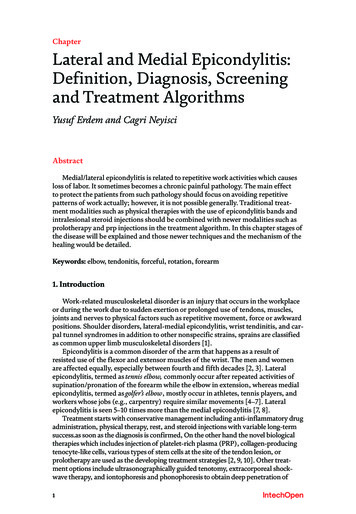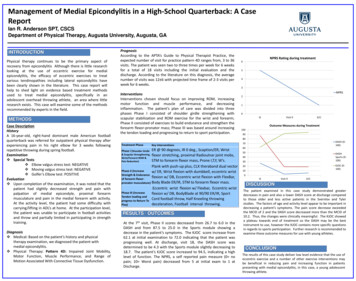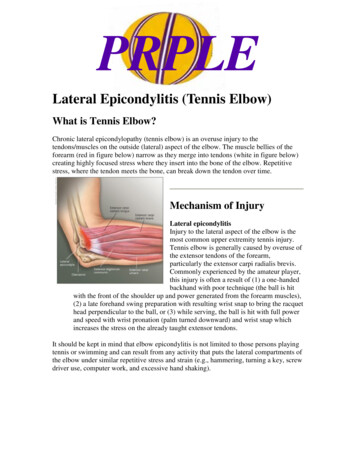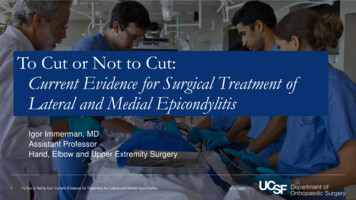
Transcription
ChapterLateral and Medial Epicondylitis:Definition, Diagnosis, Screeningand Treatment AlgorithmsYusuf Erdem and Cagri NeyisciAbstractMedial/lateral epicondylitis is related to repetitive work activities which causesloss of labor. It sometimes becomes a chronic painful pathology. The main effectto protect the patients from such pathology should focus on avoiding repetitivepatterns of work actually; however, it is not possible generally. Traditional treatment modalities such as physical therapies with the use of epicondylitis bands andintralesional steroid injections should be combined with newer modalities such asprolotherapy and prp injections in the treatment algorithm. In this chapter stages ofthe disease will be explained and those newer techniques and the mechanism of thehealing would be detailed.Keywords: elbow, tendonitis, forceful, rotation, forearm1. IntroductionWork-related musculoskeletal disorder is an injury that occurs in the workplaceor during the work due to sudden exertion or prolonged use of tendons, muscles,joints and nerves to physical factors such as repetitive movement, force or awkwardpositions. Shoulder disorders, lateral-medial epicondylitis, wrist tendinitis, and carpal tunnel syndromes in addition to other nonspecific strains, sprains are classifiedas common upper limb musculoskeletal disorders [1].Epicondylitis is a common disorder of the arm that happens as a result ofresisted use of the flexor and extensor muscles of the wrist. The men and womenare affected equally, especially between fourth and fifth decades [2, 3]. Lateralepicondylitis, termed as tennis elbow, commonly occur after repeated activities ofsupination/pronation of the forearm while the elbow in extension, whereas medialepicondylitis, termed as golfer’s elbow, mostly occur in athletes, tennis players, andworkers whose jobs (e.g., carpentry) require similar movements [4–7]. Lateralepicondylitis is seen 5–10 times more than the medial epicondylitis [7, 8].Treatment starts with conservative management including anti-inflammatory drugadministration, physical therapy, rest, and steroid injections with variable long-termsuccess.as soon as the diagnosis is confirmed, On the other hand the novel biologicaltherapies which includes injection of platelet-rich plasma (PRP), collagen-producingtenocyte-like cells, various types of stem cells at the site of the tendon lesion, orprolotherapy are used as the developing treatment strategies [2, 9, 10]. Other treatment options include ultrasonographically guided tenotomy, extracorporeal shockwave therapy, and iontophoresis and phonophoresis to obtain deep penetration of1
Work-related Musculoskeletal Disorderstopical medications into the soft tissues [11]. Surgery is performed if there is no clinicalresponse after 6–9 months of conservative treatment. Surgical techniques include openand arthroscopic approaches with dissection, release, and debridement of the degenerated and calcified tendons [12]. In our experience, we prefer a mini-open approachwhich allows a shorter recovery time and early postoperative mobilization therapy.2. Elbow anatomy2.1 Lateral elbow and epicondylitisThe extensor carpi radialis brevis, extensor digitorum communis, extensorcarpi ulnaris, brachioradialis, extensor digiti minimi, supinator and extensor carpiradialis longus are called the wrist extensors, which allow the hand to move upwardand extend. The wrist extensors form a strong conjoined tendon which is attachedat the lateral epicondyle and lateral supracondylar ridge [13] (Figure 1). Repeateduse of these tendons can cause microscopic tears and degeneration at the origin thatcan result forearm muscle weakness along with swelling and pain at the elbow. TheECRB forms the deep and anterior aspect of this common tendons and slides alongcapitellum’s lateral edge during elbow extension and flexion. This contact and sliding may play a role in the pathophysiology of epicondylitis [4, 8, 14]. The essentiallesion of lateral epicondylitis involves the ECRB mostly, followed by the extensordigitorum communis and to a lesser extent, other muscles and tendons of the lateralcompartment. Capsular injury, thickening and tearing of the lateral ulnar collateralligament (LUCL) and radial collateral ligament (RCL) have been also identified asanother cause of lateral epicondylitis [14].The lateral collateral ligament complex consists of the RCL, annular ligament,accessory lateral collateral ligament, and LUCL (Figure 2). Moreover, the LUCLruns along the lateral and posterior aspects of the radius to insert on the tubercleof the supinator crest of the ulna and disruption of which results in posterolateralrotatory instability of the elbow [14].Figure 1.Illustration shows the lateral elbow musculotendinous anatomy, close to the site of the tendon origin on thelateral epicondyle. ECRB extensor carpi radialis brevis, CET common extensor tendon, ECU extensorcarpi ulnaris, ECRL extensor carpi radialis longus, and EDC extensor digitorum communis [8].2
Lateral and Medial Epicondylitis: Definition, Diagnosis, Screening and Treatment AlgorithmsDOI: http://dx.doi.org/10.5772/intechopen.81915Figure 2.Illustration shows the ligamentous anatomy of the lateral aspect of the elbow. AL annular ligament,LUCL lateral ulnar collateral ligament, and RCL radial collateral ligament [8].2.1.1 Etiology and pathophysiologyLateral epicondylitis most commonly occurs between the ages of 30–50 yearsold. This pathology is caused by chronic stress to the forearm muscles with therepetitive activities of gripping and wrist extension. The most common movementthat results with epicondylitis is radial deviation, extension of wrist, and forearmsupination [15]. Many individuals develop lateral epicondylitis for no identifiablereason; however, poor mechanics or technique may be a reason in athletes.As it is mentioned above, this condition is an overuse degenerative process oftendons of external carpi radialis brevis and extensor digitorum communis primarily. Beside clinical symptom of prolonged pain at the elbow, histological findings aregranulation tissue, micro-rupture, an abundance of fibroblasts, vascular hyperplasia, unstructured collagen, and notably a lack of traditional inflammatory cells(macrophages, lymphocytes, neutrophils) within the tissue. In ultrasonographicevaluation calcifications, intrasubstance tears, thickening and heterogeneity of thecommon extensor tendon is mostly revealed [5, 15].2.1.2 Physical examinationProvocative testing is done by performing the Cozen’s test which is also known asresisted wrist extension test. During this test, the patient’s elbow is stabilized in 90 of flexion by the examiner’s thumb, while palpating over the patient’s lateral epicondyle. The patient is then asked to make a fist, pronate the forearm, and radiallydeviate and extend the wrist while the manual resistance of the examiner. The testis considered positive if the test produces pain or reproductive of other symptoms inthe area of the lateral epicondyle. Tenderness is usually seen over 5 mm. distal andanterior to the lateral epicondyle [15].Mill’s test is an alternative to Cozen’s test, where the patient is asked to close thehand, with the wrist in dorsiflexion and the elbow extended. During the test, thewrist is forced into flexion, while palpating over the lateral epicondyle. The patient3
Work-related Musculoskeletal Disordersdenies to do any motion, if he/she feels any pain on lateral epicondyle, and the testis considered positive [16].On the other hand, the differential diagnosis is broad (Table 1), and imaging isoften necessary when refractory or confounding symptoms are present. In a report,5% reason of lateral epicondylitis is related with radial tunnel syndrome [17].2.1.3 Diagnostic testingImaging of lateral epicondylitis not only confirms the clinical suspicion but alsoallows assessment of the injury severity and location. Multiple modalities such asmagnetic resonance imaging (MRI), computed tomographic (CT) imaging, ultrasonography and EMG have been described following initial elbow radiography.An initial x-ray evaluation should be taken in three views: anterior-posterior (AP),lateral, and lateral oblique view. The AP graphy is performed with the elbow fullyextended, palm of the hand pointing upward (exorotation) and forearm supinatedto display medial and lateral epicondyles as well as radiocapitellar and ulnotrochleararticular surfaces. The lateral view should be obtained with the hand is turned vertically, elbow in 90 of flexion, palm of the hand pointing toward patient and forearmin neutral position. Articulation between the distal humerus and proximal forearmis seen on these X-rays. Moreover the lateral oblique view is similar to the AP view,however the hand and forearm are fully externally rotated to obtain the views of theradiocapitellar joint, medial epicondyle, radioulnar joint and coronoid process.X-rays can be helpful in evaluating bony structures’ pathology, such as osteophyte formation secondary to arthritis, as well as calcifications that may be presentin tendon or muscle tissues as a result of injury. Radiographic evaluations shownormal results in most cases, and are mainly useful for ruling out other abnormalities such as arthrosis, osteochondritis dissecans and intra-articular free bodies.When X-ray is inconclusive, further studies such as MRI, ultrasound, or CT scanmay be ordered.Sonography is an inexpensive, accessible and radiation-free test. Moreoverhigh-frequency probes has an advantages of improved resolution, allowing application to extraarticular soft tissues for which it is increasingly used as an alternativeto MRI [18]. Additionally, dynamic imaging can be performed in flexion/extension,supination/pronation, or under valgus/varus stress. Dynamic sonography is alsoan ideal method of image-guided intervention and can be used to provide realtime guidance of injections of local anesthetic, steroids, or platelet-rich plasma.However, its value is debatable because it is examiner-dependent.In many cases MRI can be useful in evaluating the soft tissues for tears, fluid,inflammation, or other changes within the joint or surrounding tissues. It is a greattool to evaluate soft tissue damage due to chronic overuse injuries of the elbow.However the bony cortex is not as well evaluated at MR imaging compared with CT,but the ability to detect subtle signal intensity changes in the marrow and periostealsoft tissues increases sensitivity to early stress changes in bone. Patients positioningPosterolateral rotatory instability, LUCL injuryOsteochondritis dissecans of the capitellumOccult fractureRadial tunnel syndromeOsteoarthrosisTable 1.Differential diagnosis of lateral elbow pain.4
Lateral and Medial Epicondylitis: Definition, Diagnosis, Screening and Treatment AlgorithmsDOI: http://dx.doi.org/10.5772/intechopen.81915can be either prone or supine, with the arm held at the side in anatomical position.Inıtial evaluation includes the assessment of the radiocapitellar, ulnohumeral andradioulnar articulations of the elbow. The following examination steps are tendons,muscles, ligaments, and the three major nerves of the elbow [19, 20].CT imaging is particularly useful in demonstrating intraarticular extensionof fractures, the distribution of small fracture fragments within and adjacent tothe joint space, as well as any associated bony malalignment. CT can also be useful in evaluating chronic pain following injury and can readily identify abnormalossifications or calcifications which can be seen as a sequela of trauma, includingosteochondral bodies, heterotopic ossification, or myositis ossificans. Intraarticularcontrast material can be injected for improved visualization of joint bodies andcartilage. Osseous manifestations of secondary degenerative change are also wellevaluated with CT. Less often, CT arthrography is performed for evaluation ofligamentous integrity in patients with contraindications to MR imaging [18].Aside from imaging, many elbow pain cases will require an electromyography/nerve conduction study to investigate the function of forearm muscle in healthy anddiseased. This test consists of two parts, and utilizes needle EMG to test the musclesin the extremity. It may be helpful in nerve compressive processes. The needle EMGmay reveal the differentiation between denervation versus nerve injury or compression [21]. However future diagnosing studies are essential for this test.In case of significant swelling or fever, blood work should be indicated whetherthe reason is systemic inflammation or not. This would help direct the treatmenttoward a systemic, rheumatologic, or infectious etiology [21, 22].2.2 Medial elbow and epicondylitisThe medial epicondyle is the common origin of the flexor and pronator musclesof the forearm. Five muscles (flexor carpi radialis, palmaris longus, flexor carpiulnaris, flexor digitorum superficialis and pronator teres) share the same origin andform the conjoined flexor tendons (Figure 3) [7]. The MCL, or known as ulnar collateral ligament, is formed by anterior, posterior, and oblique bands, which createsa triangular shape along the medial aspect of the elbow, deep to the pronator massFigure 3.Illustration shows the medial elbow musculotendinous anatomy. FCU flexor carpi ulnaris, FCR flexorcarpi radialis, FDS flexor digitorum superficialis, PT pronator teres, and PL palmaris longus [8].5
Work-related Musculoskeletal Disorders(Figure 4). MCL injury, specifically anterior band injury, is included in the differential diagnosis of medial elbow pain, and therefore the MCL must be evaluated.The MCL is also prone to concurrent injury with me- dial epicondylitis.Medial epicondylitis is a tendinopathy of conjoined tendon due to overloador overuse. This pathology is also called golfer’s elbow which mostly develops asa result of high energy valgus forces in athletes. However 90% of cases are notsports-related.2.2.1 Physical examinationPatients with medial epicondylitis typically present with medial elbow pain,which often develops due to repetitive elbow use, gripping, or valgus stress. Thepain is worse with forearm motion, hand gripping and throwing. It usually resolveswith cessation of activity [4, 7, 23]. On physical examination, there may be tenderness, swelling, erythema or warmth. The tenderness is elicited by palpation over the5–10 mm distal and anterior to the medial epicondyle [4].Medial epicondylitis test involves an active and passive component where thepain is exacerbated by resisted wrist flexion and forearm pronation at an angle of90 [7]. Test is positive when the patient endorses pain with this maneuver. Dueto similar symptoms and associated valgus forces, C6–C7 radiculopathies, cubitaltunnel syndrome, ulnar neuritis, anterior interosseous nerve entrapment, tardyulnar palsy and MCL instability, as well as other causes of medial elbow pain(capsulitis, arthrofibrosis, loose bodies, or medial epicondyle avulsion fracture)should be considered in the differential diagnosis (Table 2). The Tinel sign(distal pain and tingling during direct compression of the nerve at the elbow)should be used to evaluate for ulnar neuropathy, and the ulnar collateral ligamentshould be stressed especially in athletes [23]. The elbow valgus stress test is usedto assess the integrity of the medial collateral ligament by palpating the medialjoint line and stabilizing the distal humerus in 20 degrees of elbow flexion, [23].The tests are considered positive if the patient experiences pain or excessive laxity along the MCL compared to the contralateral side.Figure 4.Picture shows the ligamentous anatomy of the medial aspect of the elbow. AL annular ligament,ant anterior band, and post posterior band [8].6
Lateral and Medial Epicondylitis: Definition, Diagnosis, Screening and Treatment AlgorithmsDOI: http://dx.doi.org/10.5772/intechopen.81915MCL İnjuryLittle League ElbowOsteochondritis dissecans (OCD)Ulnar neuropathy (ulnar neuritis, entrapment)Flexor-pronator strainOccult fractureTable 2.Differential diagnosis of medial elbow pain.2.2.2 Etiology and pathophysiologyMedial epicondylitis is generally considered to start as a microtear due to chronicstress which is related with repetitive concentric or eccentric loading of the wrist flexors and pronator teres, resulting angiofibroblastic changes. Angiofibroblastic changesinclude mucoid degeneration of the tendinous origin and formation of reactive granulation tissue [24]. As a result focal necrosis or calcification can occur with decreasingcollagen strength, scar tissue formation, and thickening of the tendons. Though it wasthought that the pronator teres and flexor carpi radialis were most commonly affected,the studies suggest that all muscles except palmaris longus are affected equally [20].Though the conservative treatment is a common intervention for the treatment,surgical treatment is applied to remove the pathologic tissues around these origins(the common flexor origin) to eliminate pain generators and decompression topromote tissue regeneration in chronic pathology.2.2.3 Diagnostic testingAs in lateral epicondylitis, imaging is not always essential in the initial evaluation of medial epicondylitis. Radiographs are most useful to rule out other causes ofelbow pain and usually normal in this pathology. Especially, in children where thediagnosis is uncertain, comparison to the unaffected arm may be necessary.Sonography is also a quick, easy and cost-effective modality to evaluate tendonpathology and distinguish from other etiologies. Moreover dynamic evaluation canbe done in areas of chronic degeneration.MRI is the ideal diagnostic imaging modality in medial epicondylitis and ruleout other possible causes of elbow pain like MCL strain, osteochondritis dissecans,or other soft tissue injuries.Computed tomography, electromyogram and bone scan may be useful in refractory cases to rule out other etiologies as well [23].2.2.4 TreatmentOnce the diagnosis is clear, offending activities including decreasing the volume,frequency, or intensity should be cascaded. Beside, patients may respond to nonsteroidal anti-inflammatory drugs and acetaminophen as an initial step. Also topical nitroglycerin patches have proven helpful in the treatment of tendinopathies.Most cases of epicondylitis are managed conservatively. Though medial epicondylitis is less common compared to lateral epicondylitis, the treatment is more difficult.The primary goal of the first step of treatment includes pain and inflammation relief. Modification of life style is important. Physical therapy takes a greatrole for the management of treatment simultaneously. Multiple physical therapy7
Work-related Musculoskeletal Disordersmodalities including dry needling, etracorporeal shock wave therapy, iontophoresis, electrical stimulation and ultrasonography takes great role to overcomethis pathology [25–28]. Theoretically, eccentric strengthening efficiently induceshypertrophy of the musculotendinous unit and increases it tensile strength,thereby reducing strain of the tendon. Therapy was more effective than rest andrestriction of activities.Counterforce bracing (forearm bands) inhibits full muscular expansion anddecreases the force on the muscular tissue proximal to the brace. Night splintingwith a cock up wrist splint and elbow kinesio taping may be helpful. In case ofnon-compliance or when these treatment modalities are not available injectionsare used. Currently corticosteroids (especially betamethasone sodium phosphateand dipropionate) and local anesthetic mixture is the most common, howeverrecent studies have shown a new group of injectable substances such as botulinumtoxin, autologous blood, platelet-rich plasma, hyaluronic acid and prolotherapyare being utilized [29]. Recent studies have shown that Visual Analog Scale (VAS)pain scores and functional scores during the first 2–6 weeks (acute period) haveimproved after the injections mentioned above [2]. However the dose and frequency of the corticosteroids or others is still controversial. Moreover the corticosteroid injection may result with local skin atrophy, depigmentation and musclewasting [2].Botulinum toxin A have been shown as an off-label treatment and have someliterature support in refractory cases. It has also has the ability to cause a partialparalysis of the wrist flexors and extensors and allow the pathologic tissue to healwhile avoiding micro trauma to the tendon. In a study, 60 patients who received ablinded injection of botulinum toxin or placebo have been evaluated with results ofsignificant lower VAS pain scores at 4 and 12 weeks in the botulinum toxin group.On the other hand the major adverse effect seen with botulinum toxin injection isfinger and wrist extensor weakness [30].Autologous blood injection has been described by Edwards and Calandruccio[31]. Autologous platelet-rich plasma (PRP) have been shown to reduce pain andimprove function in refractory epicondylitis [31]. Mishra and Pavelko reported significantly better VAS and functional scores at 8-week period compared to placebo[32]. In conclusion, the effect of remaining injection modalities, which are knownas PRP and autologous whole blood, are about the chronic cases with a persistentefficacy during long term follow up. At the end hyaluronic acid and prolotherapyinjections have also been studied for epicondylitis have been found to be effective inrefractory cases however the mechanism is not well known [33, 34].Surgical indications for medial and lateral epicondylitis include persistent painand weakness of the forearm that persists after a period of at least 6 months ofconservative care, however it is usually not needed. These surgeries involve releaseof the common flexor and extensor tendon at the epicondyle and debridement ofpathologic tissue. The mini-open muscle resection involves removal of degenerativetissue of the flexor carpi radialis. Fascial elevation and tendon origin resection isanother available technique [34]. The prognosis for recovery is very good with reliefof pain, but often results in weakness of the forearm musculature [33].3. DiscussionMedial and lateral epicondylitis is a chronic inflammation disease which resultsin loss of labor. Moreover these pathologies are related with other upper extremity abnormalities most of which are accompanied with cervical disc pathologies.Physician should be aware of other conditions which led to or mimics epicondylitis.8
Lateral and Medial Epicondylitis: Definition, Diagnosis, Screening and Treatment AlgorithmsDOI: http://dx.doi.org/10.5772/intechopen.81915The patients’ social status and job should be questioned at first intervention, thusthe treatment varies depending on the situation. If a pure epicondylitis is diagnosed the treatment algorithm is defined above beginning conservatively at first tosurgery at last. The aim of the treatment is directed to return to activity as well.Author detailsYusuf Erdem1* and Cagri Neyisci21 Gulhane Training and Research Hospital, Ankara, Turkey2 Gulhane Training and Research Hospital, Department of Orthopaedic Surgey,Ankara, Turkey*Address all correspondence to: yerdem81@gmail.com 2019 The Author(s). Licensee IntechOpen. This chapter is distributed under the termsof the Creative Commons Attribution License (http://creativecommons.org/licenses/by/3.0), which permits unrestricted use, distribution, and reproduction in any medium,provided the original work is properly cited.9
Work-related Musculoskeletal DisordersReferences[1] Bepko J, Mansalis K. Commonoccupational disorders:Asthma, COPD, dermatitis,and musculoskeletal disorders.American Family Physician.2016;93(12):1000-1006[2] Tarpada SP, Morris MT, Lian J,Rashidi S. Current advances in thetreatment of medial and lateralepicondylitis. Journal of Orthopaedics.2018;15(1):107-110[3] Shiri R, Viikari-Juntura E, VaronenH, Heliövaara M. Prevalence anddeterminants of lateral and medialepicondylitis: A population study.American Journal of Epidemiology.2006;164(11):1065-1074[4] Bernard FM, Regan WD. Elbowand forearm. In: DeLee JC, editor.DeLee and Drez’s Orthopaedic SportsMedicine. 2nd ed. Philadelphia, PA:Saunders; 2003[9] Ikpe S, Lesniak B. Biologics and cell-based treatments for upper extremityinjuries. Operative Techniques inOrthopaedics. 2016;26(3):177-181[10] Connell D, Datir A, Alyas F, CurtisM. Treatment of lateral epicondylitisusing skin-derived tenocyte-like cells.British Journal of Sports Medicine.2009;43(4):293-298[11] Faro F, Wolf JM. Lateralepicondylitis: Review and currentconcepts. The Journal of Hand Surgery.2007;32:1271-1279[12] Cohen MS, Romeo AA, HenniganSP, Gordon M. Lateral epicondylitis:Anatomic relationship of the extensortendon origins and implicationsfor arthroscopic treatment. Journalof Shoulder and Elbow Surgery.2008;17:954-960[13] Blease S, Stoller DW, Safran MR,medial epicondylitis. In: Morrey BF,editor. Master Techniques in OrthopedicSurgery: The Elbow. NewYork, NY:Raven; 1994. pp. 537-552Li AE, Fritz RC. The elbow. In: StollerDW, editor. Magnetic ResonanceImaging in Orthopaedics and SportsMedicine. 3rd ed. Philadelphia, PA:Lippincott, Williams & Wilkins; 2007.pp. 1463-1626[6] Coonrad RW, Hooper WR. Tennis[14] Bunata RE, Brown DS, Capelo R.[5] Nirschl RP, Pettrone FA. Lateral andelbow: Its course, natural history,conservative and surgicalmanagement. The Journal of Boneand Joint Surgery. American Volume.1973;55:1177-1182[7] Ciccotti MC, Schwartz MA,Anatomic factors related to the causeof tennis elbow. The Journal of Boneand Joint Surgery. American Volume.2007;89:1955-1963[15] Smidt N, Lewis M, Van Der WindtCiccotti MG. Diagnosis and treatmentof medial epicondylitis of theelbow. Clinics in Sports Medicine.2004;23:693-705DA, Hay EM, Bouter LM, Croft P.Lateral epicondylitis in general practice:Course and prognostic indicators ofoutcome. The Journal of Rheumatology.2006;33(10):2053-2059[8] Walz DM, Newman JS, Konin GP,[16] Filho M, Cotovelo GR. In: BarrosRoss G. Epicondylitis: Pathogenesis,imaging, and treatment. RadioGraphics.2010;30(1):167-18410Filho TEP, Lech O, editors. Exame Físicoem Ortopedia. São Paulo: Sarvier; 2001.pp. 138-156
Lateral and Medial Epicondylitis: Definition, Diagnosis, Screening and Treatment AlgorithmsDOI: http://dx.doi.org/10.5772/intechopen.81915[17] Ferdinand BD, Rosenberg ZS,Schweitzer ME, et al. MR imagingfeatures of radial tunnel syndrome:Initial experience. Radiology.2006;240:161-168[18] Potter HG. Imaging ofposttraumatic and soft tissuedysfunction of the elbow. ClinicalOrthopaedics. 2000;370:9-18Group. Archives of Family Medicine.1997;6:257-262[26] Burnham R, Gregg R, Healy P,Steadward R. The effectivenessof topical Diclofenac for lateralepicondylitis. Clinical Journal of SportMedicine. 1998;8:78-81[27] Bisset L, Paungmali A, Vincenzinoof the pediatric elbow. In: The Elbowand its Disorders. Philadephia, PA:Saunders; 2000. pp. 155-163B, Beller E. A systematic reviewand meta analysis of clinical trialson physical interventions for lateralepicondylalgia. British Journal of SportsMedicine. 2005;39:411-422[20] Srinath CS, Srihari S, Miriam B.[28] Pettrone FA, McCall BR.[19] Hoffman AD, Graviss ER. ImagingMagnetic resonance imaging of theelbow: A structured approach. SportsHealth. 2013;5(1):34-49[21] Braddom RL, Chan L, Harrast MA,Kowalske KJ, Matthews DJ, RagnarssonKT, et al. Physical Medicine andRehabilitation. 4th ed. Philadelphia:Saunders; pp. 825-838[22] Bonica JJ. In: Fishman S, BallantyneJ, Rathmell JP, editors. Bonica’sManagement of Pain. Philadelphia:Lippincott Williams & Wilkins; 2010.pp. 1034-1028[23] Han SH, Lee JK, Kim HJ, Lee SH,Kim JW, Kim TS. The result of surgicaltreatment of medial epicondylitis:Analysis with more than a 5-yearfollow-up. Journal of Shoulder andElbow Surgery. 2016;25(10):1704-1709[24] Goran R, Violeta Vm Mihaela M,Rodina N, Tzvetanka P, Francesco P,Annamaria I. Ultrasound assessmentof the elbow. Medical Ultrasonography.2012;14(2):141-146[25] Labelle H, Guibert R. “Efficacyof Diclofenac in lateral epicondylitisof the elbow also treated withimmobilization:” The Universityof Montreal Orthopaedic Reseach11Extracorporeal shock wave therapywithout local anesthesia for chroniclateral epicondylitis. The Journal ofBone and Joint Surgery. AmericanVolume. 2005;87:1297-1304[29] Groppel JL, Nirschl RP. Amechanical and electromyographicalanalysis of the effects of various jointcounterforce braces on the tennisplayer. The American Journal of SportsMedicine. 1986;14:195-200[30] Sm W, Hui AC, Tong PY, Poon DW,Yu E, Wong LK. Treatment of lateralepicondylitis with botulinum toxin: Arandomized, double-blind, placebocontrolled trail. Annals of InternalMedicine. 2005;143(1):793-797[31] Edwards SG, Calandruccio JH.Autologous blood injections forrefractory lateral epicondylitis.The Journal of Hand Surgery. 2003Mar;28(2):272-278[32] Mishra A, Pavelko T. Treatmentof chronic elbow tendinosis withbuffered platelet-rich plasma. TheAmerican Journal of Sports Medicine.2006;34:1774-1778[33] Degen RM, Cancienne JM, CampCL, Altchek DW, Dines JS, WernerBC. Patient-related risk factors for
Work-related Musculoskeletal Disordersrequiring surgical interventionfollowing a failed injection for thetreatment of medial and lateralepicondylitis. The Physician andSportsmedicine. 2017;45(4):433-437[34] Raeissadat SA, Ranyegani SM,Hassanabadi H, Rahimi R, SedighipourL, Rostami K. Is platelet-rich plasmasuperior to whole blood in themanagement of chronic tennis elbow:One year randomized clinical trial.BMC Sports Science, Medicine andRehabilitation. 2014;6(1):1212
epicondylitis is seen 5-10 times more than the medial epicondylitis [7, 8]. Treatment starts with conservative management including anti-inflammatory drug administration, physical therapy, rest, and steroid injections with variable long-term success.as soon as the diagnosis is confirmed, On the other hand the novel biological





